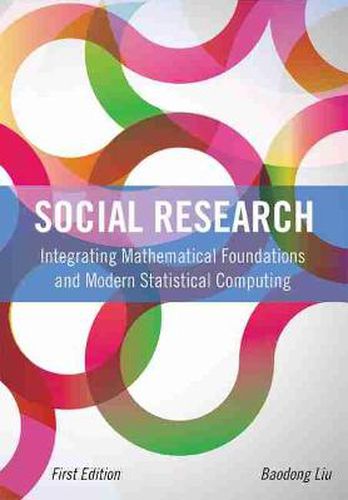Readings Newsletter
Become a Readings Member to make your shopping experience even easier.
Sign in or sign up for free!
You’re not far away from qualifying for FREE standard shipping within Australia
You’ve qualified for FREE standard shipping within Australia
The cart is loading…






This title is printed to order. This book may have been self-published. If so, we cannot guarantee the quality of the content. In the main most books will have gone through the editing process however some may not. We therefore suggest that you be aware of this before ordering this book. If in doubt check either the author or publisher’s details as we are unable to accept any returns unless they are faulty. Please contact us if you have any questions.
Like quantitative analysis itself, the text Social Research begins with a question. Why do social scientists use numbers to talk about everything from the stock market to human emotions?
Social Research provides an answer with its common sense approach to the quantitative scientific method. The book balances imagination and reason with theoretical and mathematical information processing to help students understand the important link between social research and foundational math skills.
Initially, readers are asked to consider the type of tasks to which such analysis might be applied. They learn about conceptualization, units of analysis, and the quantitative mind. These can then be applied as students explore specific tools, including measurement, variables, hypothesis and experiment, and controlled comparison. It shows detailed examples of how to use both SPSS and R software programs for basic statistical operations and programming needs.
The book also discusses random sampling, the central limit theorem, Type I and Type II errors and bivariate and multiple regression.
Social Research is about why science works, and while it includes mathematics, it does so in an accessible way. The book is suitable for undergraduate methods courses that meet the requirement for quantitative sciences, and it can also be a supplemental text to first graduate-level quantitative method classes that require mathematical training.
$9.00 standard shipping within Australia
FREE standard shipping within Australia for orders over $100.00
Express & International shipping calculated at checkout
This title is printed to order. This book may have been self-published. If so, we cannot guarantee the quality of the content. In the main most books will have gone through the editing process however some may not. We therefore suggest that you be aware of this before ordering this book. If in doubt check either the author or publisher’s details as we are unable to accept any returns unless they are faulty. Please contact us if you have any questions.
Like quantitative analysis itself, the text Social Research begins with a question. Why do social scientists use numbers to talk about everything from the stock market to human emotions?
Social Research provides an answer with its common sense approach to the quantitative scientific method. The book balances imagination and reason with theoretical and mathematical information processing to help students understand the important link between social research and foundational math skills.
Initially, readers are asked to consider the type of tasks to which such analysis might be applied. They learn about conceptualization, units of analysis, and the quantitative mind. These can then be applied as students explore specific tools, including measurement, variables, hypothesis and experiment, and controlled comparison. It shows detailed examples of how to use both SPSS and R software programs for basic statistical operations and programming needs.
The book also discusses random sampling, the central limit theorem, Type I and Type II errors and bivariate and multiple regression.
Social Research is about why science works, and while it includes mathematics, it does so in an accessible way. The book is suitable for undergraduate methods courses that meet the requirement for quantitative sciences, and it can also be a supplemental text to first graduate-level quantitative method classes that require mathematical training.